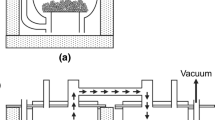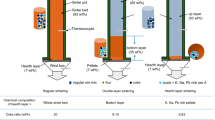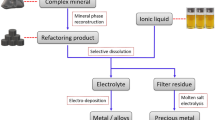Abstract
Large amounts of manganese-rich slag were generated from smelting low-grade manganese ore containing high iron and high phosphorus in electric furnace or blast furnace, which contain 25–40 mass% Mn. This paper describes an efficient hydrometallurgical process for the utilization of high manganese slag instead of conventional usage of pyrometallurgical route for manganese recovery. Pressure acid leaching of manganese-rich slag using air as pressurized gas is studied systematically. The effects of mass ratio of manganese-rich slag to pyrite, concentration of sulfuric acid, leaching temperature, partial air pressure, leaching time, and liquid-solid (L/S) ratio on the separation of manganese with other main impurity components were investigated comprehensively. Under the following optimal process conditions, weight of manganese-rich slag powder,100 g; mass ratio of manganese-rich slag to pyrite, 20:1; sulfuric acid concentration of 140 g/L; air pressure of 0.6 MPa; leaching temperature of 140 °C; leaching time of 1 h; L/S of 7:1; ore size of 75–80 μm; and stirring rate of 600 rpm, the extraction rate of Mn reached 94%, and the dissolution percentage of Si, Al, and Fe are as low as 2%, 6%, and 10%, respectively. The leaching slurry presented a good solid-liquid separation characteristic. The silicic acid formed during sulfuric acid leaching manganese silicates was converted to filterable dehydrated SiO2 particles which precipitated in the residue under the condition of higher temperature with higher pressure. The effect of adding pyrite may be to reduced iron ions and decreased the output of iron hydroxide colloid and also reduced MnO2 to manganese sulfate in sulfuric acid leaching. Thus the formation possibility of colloid such as silica gel and iron hydroxide was decreased, and higher yield of manganese sulfate could be achieved.









Similar content being viewed by others
References
Ahmed A, El-Mohammady A, Eissa M, El-Fawakhry K (2007) Factors affecting silicomanganese production using manganese rich slag in the charge. Steel Research int 78(1):24–30
Nath SK, Kumar S (2016) Evaluation of the suitability of ground granulated silico-manganese slag in Portland slag cement. Constr Build Mater 125:127–134
Pareuil P, Bordas F, Joussein E, Vieillard P, Bollinger J-C (2010) Leaching experiments on a Mn-rich slag from the recycling of alkaline batteries–solid phase characterization and geochemical modeling. Appl Geochem 25:1187–1197
Allahverdi A, Ahmadnezhad S (2014) Mechanical activation of silicomanganese slag and its influence on the properties of Portland slag cement. Powder Technol:251, 41–251
Zhiming Z, Wenzheng S, Kun L (2007) The process investigation of preparing anhydrous MnCl2 from manganese-rich slag. Inorganic Chemicals Industry 39:50–52
Zhang W, Cheng C (2007) Manganese metallurgy review. Part I: Leaching of ores/secondary materials and recovery of electrolytic/chemical manganese dioxide. Hydrometallurgy 89:137–159
Hongsheng X, Chang W, Cunxiong L, Zhigan D, Gang F, Minting L, Xingbin L (2014) Selective recovery of valuable metals from partial silicated sphalerite at elevated temperature with sulfuric acid solution. J Ind Eng Chem 20:1373–1381
Farrah HE, Lawrance GA, Wanless EJ (2007) Solubility of calcium sulfate salts in acidic manganese sulfate solutions from 30 to 105 °C. Hydrometallurgy 86:13–21
Wu C, Yu H, Zhang H (2012) Extraction of aluminum by pressure acid-leaching method from coal fly ash. Trans Nonferrous Metals Soc China 22(9):2282–2288
Huang F, Liao Y, Zhou J, Wang Y, Li H (2015) Selective recovery of valuable metals from nickel converter slag at elevated temperature with sulfuric acid solution. Sep Purif Technol 156:572–581
He S, Jikun W, Jiangfeng Y (2010) Pressure leaching of high silica Pb–Zn oxide ore in sulfuric acid medium. Hydrometallurgy 104:235–240
Funding
This work was financially supported by the National Natural Science Foundation of China (No. 51704133) and the Innovation and Entrepreneurship Training Program for University Students (No. DC2018-015).
Author information
Authors and Affiliations
Corresponding author
Ethics declarations
Conflict of Interest
The authors certify that there is no conflict of interests with any individual/organization for the present work.
Additional information
Publisher’s Note
Springer Nature remains neutral with regard to jurisdictional claims in published maps and institutional affiliations.
Rights and permissions
About this article
Cite this article
He, S., Liao, C., Wang, X. et al. Pressure Sulfuric Acid Leaching of Manganese-Rich Slag with Pyrite as Additive. Mining, Metallurgy & Exploration 37, 433–442 (2020). https://doi.org/10.1007/s42461-019-00169-6
Received:
Accepted:
Published:
Issue Date:
DOI: https://doi.org/10.1007/s42461-019-00169-6




